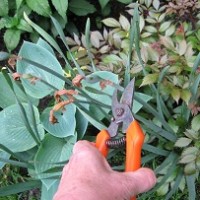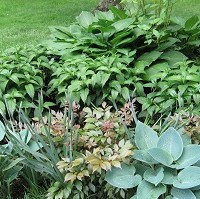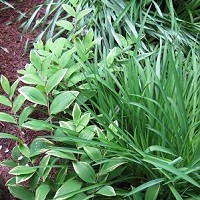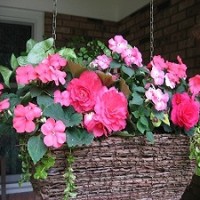Goodbye Spring–Hello Summer
Today is Memorial Day and a day for remembrance of America’s fallen patriots who have ensured ongoing liberty. For many gardeners, though, it has also become a border crossing saying “Goodbye Spring” and “Hello Summer!”
Among the Spring Goodbyes are a farewell to tulips and daffodils. The blossoms of many of these—except the latest season tulips—have faded and the inevitable question arises of how to deal with the dying foliage. Let’s face it: dying foliage looks unsightly whether it’s cool spring beauties dying with the heat of summer or summer splendor dying as the frosts of fall bring the growing season to a close.
 How do you deal with dying daffodil leaves? People have often suggested that they tie daffodil foliage in bundles or braid it; some cut it off completely; some leave it to die; and others ask about the best way of dealing with dying foliage of daffodils and tulips.
How do you deal with dying daffodil leaves? People have often suggested that they tie daffodil foliage in bundles or braid it; some cut it off completely; some leave it to die; and others ask about the best way of dealing with dying foliage of daffodils and tulips.
I normally do two things: First, I cut off the blossom end with pruning shears or scissors. The purpose of this is to prevent the bulb from going to seed and depriving next year’s bulb of valuable food. Second, to ensure that the foliage can make food and die in its season—yet not be an eyesore—I interplant daffodils and tulips among other plants so the dying foliage will be hidden among the new growth. Braiding, bunching, and removing the foliage prevents the leaves from making necessary food.
 Pictured here are two instances of daffodil inter-planting. In the wet area of my yard, the hostas, astilbe, turtlehead have emerged and I can tuck the foliage behind these companion plants until it has completely died back. The foliage will continue to make food with plenty of sunlight and grow the bulk of the bulbs, then the summer perennials will fill the space left behind as the daffodils recede.
Pictured here are two instances of daffodil inter-planting. In the wet area of my yard, the hostas, astilbe, turtlehead have emerged and I can tuck the foliage behind these companion plants until it has completely died back. The foliage will continue to make food with plenty of sunlight and grow the bulk of the bulbs, then the summer perennials will fill the space left behind as the daffodils recede.
Daffodils interplant beautifully with daylilies and variegated Solomon Seal. Tulips and hostas are also a natural companion planting for part sun areas.

Again, careful plant selection is helpful.
If your tulips are in full sun, then consider daylilies, coneflowers, or Rudbeckia. If they are in part sun, hostas, astilbe, cranesbill geranium would be good companion plant choices. Some of the earliest season tulips finish their blooming/receding cycle before the trees experience bud break, so these Greigii, Kaufmann, and other early tulips can be planted in areas along with small scale hostas that will be shaded later in the summer.
Plant selection is important for the garden but even more important for container gardens.
 Since a container garden must share the same watering requirement and light level, taking care to select compatible companions is helpful. Consider these hanging baskets I made from two window boxes back to back. They are hung from their back loops by using chain link (painted with craft paint to reduce its sheen). The back window box has maidenhair fern, ivy, fittonia, and nepthytis and the front window box has creeping jenny/moneywort, coleus, tuberous begonia, and impatiens. Since I will never rotate these, the front box will get brighter light and the back box will be even more shaded and moist. I like the stewardship present as well since the maidenhair fern, ivy, fittonia and nepthytis are all houseplants that I’m summering outdoors and the creeping jenny was recycled from early spring pots. I enjoy creating beautiful things primarily from what I already have on hand, plus an added item or two. Beauty from season to season!
Since a container garden must share the same watering requirement and light level, taking care to select compatible companions is helpful. Consider these hanging baskets I made from two window boxes back to back. They are hung from their back loops by using chain link (painted with craft paint to reduce its sheen). The back window box has maidenhair fern, ivy, fittonia, and nepthytis and the front window box has creeping jenny/moneywort, coleus, tuberous begonia, and impatiens. Since I will never rotate these, the front box will get brighter light and the back box will be even more shaded and moist. I like the stewardship present as well since the maidenhair fern, ivy, fittonia and nepthytis are all houseplants that I’m summering outdoors and the creeping jenny was recycled from early spring pots. I enjoy creating beautiful things primarily from what I already have on hand, plus an added item or two. Beauty from season to season!


Leave a Reply